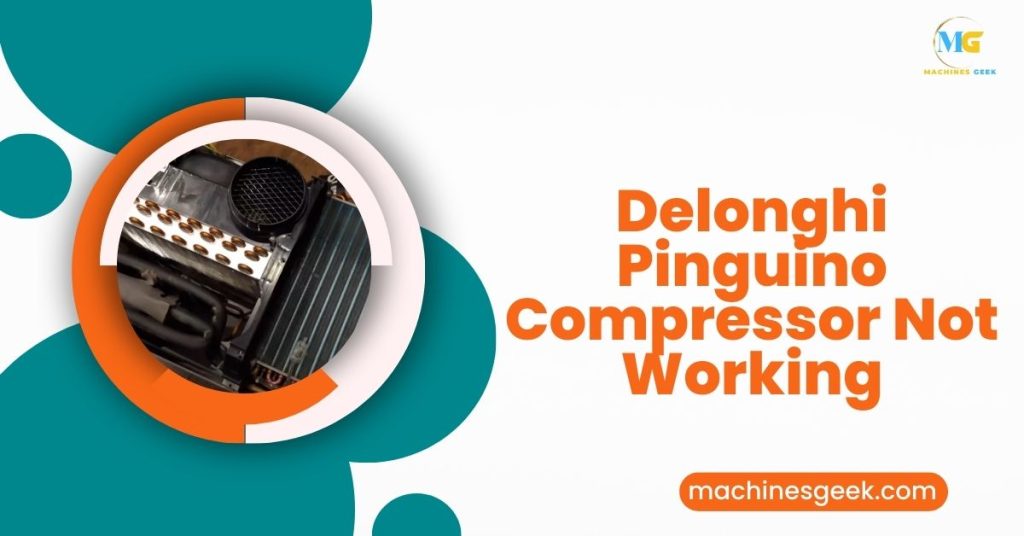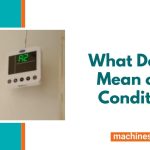The Pinguino compressor may not be working due to a malfunction, which can be fixed by diagnosing and repairing the issue. We will discuss common reasons why the compressor may not be working and provide possible solutions to resolve the problem, ensuring your Pinguino air conditioner operates efficiently.
When it comes to using an air conditioner, it can be frustrating if the compressor fails to work. The compressor plays a crucial role in the cooling process by compressing and circulating refrigerant within the system. If your Delonghi Pinguino compressor is not working, it can be indicative of a bigger problem.
We will explore the potential causes and solutions for a malfunctioning compressor, allowing you to restore the functionality of your air conditioner and stay cool.
Leaking Refrigerant
Refrigerant leaks in your Delonghi Pinguino compressor can lead to issues with its cooling performance. Identifying the signs of a refrigerant leak is crucial in order to address the problem promptly. Look out for indicators such as insufficient cooling, ice buildup on the evaporator coils, or hissing sounds near the unit.
Several factors can contribute to refrigerant leaks. Common causes include corrosion of the copper tubing, faulty connections or fittings, vibration damage, or manufacturing defects. It is important to determine the exact cause of the leak to prevent any further damage to your Pinguino compressor.
Repairing a refrigerant leak depends on the size and location of the leak. Small leaks may be repaired by simply brazing or soldering the affected area. However, larger or more complex leaks may require replacing the damaged components or even the entire refrigerant system. It is advisable to consult a professional technician for proper repair and maintenance.
Regular maintenance and proper usage of your Delonghi Pinguino compressor can help prevent refrigerant leaks. Ensure that the unit is installed correctly, with proper insulation and secure connections. Additionally, schedule annual inspections to identify any potential leaks or issues before they become major problems.
Electrical Malfunctions
Electrical malfunctions can be a common issue with the Delonghi Pinguino compressor. If you are facing problems with the compressor not working, there are several troubleshooting steps you can take. Firstly, check for any loose connections or damaged wires and ensure that the power source is functioning properly. If you find faulty electrical components, it is important to consider replacement options. Consult a professional technician who can guide you in choosing and installing the right components.
Maintaining the electrical components of your Delonghi Pinguino compressor is crucial to ensure its optimal performance. Regular inspections can help identify any potential issues early on and prevent major malfunctions. Make sure to keep the compressor clean and free from dust or debris. Consider using a surge protector to protect the electrical system from power fluctuations. Additionally, follow the manufacturer’s guidelines for maintenance and take any necessary precautions to avoid electrical damages.
Compressor Overheating
Delonghi Pinguino is a popular brand of portable air conditioners. One common issue that users may encounter is a compressor not working properly, often due to overheating. Compressor overheating can be caused by various factors, including inadequate airflow, dirty condenser coils, refrigerant issues, or electrical problems. If your unit is experiencing compressor overheating, you may notice symptoms such as reduced cooling performance, frequent cycling on and off, or hot air coming from the vents.
To prevent compressor overheating, it is important to ensure proper maintenance of your Pinguino unit. Regularly clean the filters and condenser coils to maintain good airflow. Check the refrigerant levels and electrical connections to make sure everything is functioning correctly. Additionally, providing proper ventilation around the unit and avoiding placing it in direct sunlight can also help prevent overheating.
If you want to protect the compressor from overheating, consider taking certain precautions. Avoid running the unit continuously for long periods without breaks, as this can strain the compressor. Use the unit in a suitable room size to prevent overworking the compressor. Finally, consider consulting a professional if you suspect any underlying issues that may be causing the compressor to overheat.
Insufficient Cooling
The Delonghi Pinguino Compressor not working properly can lead to insufficient cooling in your home. There can be several possible reasons for this issue.
Firstly, check if the air filters are clean and not clogged as dirty filters can affect cooling efficiency.
Secondly, ensure that the thermostat is set to the correct temperature and that the unit is not overworked. T
hirdly, check for any leaks in the system that may be causing refrigerant loss.
Fourthly, make sure that the compressor is not faulty and is functioning properly.
To troubleshoot the issue, you can start by cleaning or replacing the air filters. Next, check the thermostat settings and adjust if necessary. If there are any leaks, they should be sealed and the refrigerant levels should be checked and refilled if needed. Regular maintenance and cleaning of the compressor and other components can also help improve cooling efficiency. Additionally, make sure the Pinguino Compressor is not placed in direct sunlight or near any heat sources. By following these steps and performing regular maintenance, you can avoid cooling problems and ensure effective cooling from your Delonghi Pinguino Compressor.
Compressor Not Turning On
A compressor not turning on is a common issue that can occur with a Delonghi Pinguino air conditioner. There can be multiple potential causes for this problem:
- Faulty power connection: Ensure that the air conditioner is properly plugged into a working power outlet.
- Tripped circuit breaker: Check the circuit breaker and reset it if necessary.
- Thermostat settings: Make sure the thermostat is set to a lower temperature than the current room temperature.
- Defective compressor relay: The compressor relay may be faulty and in need of replacement.
- Overload protection: If the compressor is overloaded, it may not turn on. Allow the unit to cool down and try again.
To troubleshoot the issue and diagnose the specific cause, follow these steps:
- Check the power supply and ensure all connections are secure.
- Inspect the thermostat settings and adjust if needed.
- Examine the compressor relay and test for proper functionality.
If the compressor still isn’t working after troubleshooting, you may need to consider professional assistance for complex issues or contact Delonghi customer support for further guidance.
Strange Noises And Vibrations
The Delonghi Pinguino may experience strange noises and vibrations when the compressor is not working properly, indicating a potential issue with the unit. Proper maintenance and troubleshooting may be required to resolve the problem and restore optimal performance.
Common noises and vibrations in Delonghi Pinguino compressors:
| Noise Type | Possible Cause |
| Rattling or buzzing | Loose parts or debris in the compressor |
| Squealing or screeching | Worn-out fan belt or motor bearing |
| Banging or knocking | Compressor pistons hitting against each other |
| Vibrations | Imbalanced compressor or loose mounting screws |
Causes of abnormal sounds and vibrations:
Excessive noise and vibrations in Delonghi Pinguino compressors can be caused by various factors. Loose parts or debris in the compressor can result in rattling or buzzing noises. Squealing or screeching sounds may indicate a worn-out fan belt or motor bearing. Banging or knocking noises could be a result of compressor pistons hitting against each other. Vibrations can occur when the compressor is imbalanced or when the mounting screws are loose.
How to reduce noise and vibrations:
To reduce noise and vibrations, it is essential to perform regular maintenance on your Delonghi Pinguino compressor. Clean and tighten all screws and connections to prevent vibrations. Lubricate the compressor motor and fan bearings to ensure smooth operation. Check and replace worn-out parts, such as fan belts or motor bearings, as needed. Additionally, placing the compressor on a vibration-dampening pad can help minimize vibrations and noise transmission to the surrounding area.
Importance of regular maintenance for noise prevention:
Regular maintenance is crucial for preventing excessive noise in Delonghi Pinguino compressors. By keeping the compressor clean and well-maintained, you can minimize the risk of loose parts causing unwanted noises. Routine inspections and timely repairs or replacements of worn-out components help ensure optimal performance and reduce the likelihood of abnormal sounds occurring. Don’t neglect regular maintenance if you want to keep your Delonghi Pinguino compressor operating quietly and efficiently.
Proper Installation And Placement
Proper installation and placement of the Delonghi Pinguino compressor unit is crucial for its efficient operation. Incorrect positioning can lead to poor cooling performance and even compressor failure. Here are some tips to ensure that your unit is properly installed and positioned:
- Keep the unit at least 20 inches away from any walls or furniture to ensure proper airflow.
- Avoid placing the unit in direct sunlight or near any heat sources, as this can affect its cooling capacity.
- Ensure that there is adequate clearance around the unit for easy access and maintenance.
- Make sure that the unit is placed on a flat, stable surface to prevent vibration and noise.
- Consider using a window seal kit or a sliding glass door kit to properly vent the exhaust air.
It is important to avoid common installation mistakes such as blocking the intake or exhaust vents, or using extension cords that are not rated for the unit’s power requirements. If you are unsure about the correct installation and placement, it is recommended to seek professional help. A qualified technician can ensure that your Delonghi Pinguino compressor is installed correctly and positioned for optimal performance.
Regular Cleaning And Maintenance
Regular maintenance and cleaning are crucial for the longevity of the compressor in your Delonghi Pinguino. Cleaning techniques vary depending on the different components of the compressor. It is important to clean the air filters regularly to ensure proper airflow and prevent dust and debris from clogging the system. Additionally, cleaning the condenser coils can help maintain optimal cooling performance.
A maintenance schedule should be followed to ensure that all necessary cleaning tasks are performed at regular intervals. This includes checking and cleaning the condensate drain, inspecting the fan blades for any dirt buildup, and lubricating the motor bearings if required.
While regular cleaning can help maintain the compressor’s efficiency, professional maintenance services are also highly recommended. Professional technicians have the expertise to thoroughly clean and inspect all components, identify any potential issues, and provide necessary repairs or replacements.
Is the Compressor Issue a Common Problem with Different Types of Air Conditioners?
Yes, the RV air conditioner compressor issue is a common problem across different types of air conditioners. The compressor is a crucial component that can malfunction due to various reasons, leading to problems with cooling efficiency and overall performance. Regular maintenance and timely repairs can help minimize the chances of this issue.
Frequently Asked Questions
Why Is My Delonghi Pinguino Compressor Not Working?
The Delonghi Pinguino compressor may not be working due to a faulty thermostat or a refrigerant leak.
How Do I Troubleshoot My Delonghi Pinguino Compressor?
To troubleshoot a Delonghi Pinguino compressor, check for power supply issues, clean the air filters, and ensure proper ventilation.
Can I Fix The Delonghi Pinguino Compressor Myself?
Fixing the Delonghi Pinguino compressor yourself is not recommended. It’s best to contact a professional technician for repairs to ensure safety and proper resolution.
Conclusion
The non-functioning of the Delonghi Pinguino compressor can be a frustrating issue for users. However, by following the troubleshooting steps outlined in this blog post, you can effectively resolve the problem. From checking the power supply to inspecting the fan and filter, these simple solutions can save you time and money.
Be sure to maintain your unit properly to prolong its lifespan and prevent future issues. Happy cooling!








